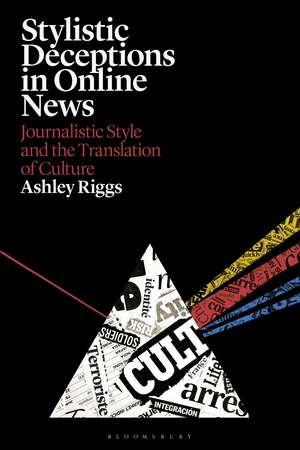Stylistic Deceptions in Online News: Journalistic Style and the Translation of Culture
Autor Dr Ashley Riggsen Limba Engleză Hardback – 14 oct 2020
| Toate formatele și edițiile | Preț | Express |
|---|---|---|
| Paperback (1) | 197.24 lei 6-8 săpt. | |
| Bloomsbury Publishing – 20 apr 2022 | 197.24 lei 6-8 săpt. | |
| Hardback (1) | 714.68 lei 6-8 săpt. | |
| Bloomsbury Publishing – 14 oct 2020 | 714.68 lei 6-8 săpt. |
Preț: 714.68 lei
Preț vechi: 1027.76 lei
-30% Nou
Puncte Express: 1072
Preț estimativ în valută:
136.77€ • 142.26$ • 112.91£
136.77€ • 142.26$ • 112.91£
Carte tipărită la comandă
Livrare economică 14-28 aprilie
Preluare comenzi: 021 569.72.76
Specificații
ISBN-13: 9781350114173
ISBN-10: 1350114170
Pagini: 224
Dimensiuni: 156 x 234 mm
Greutate: 0.49 kg
Editura: Bloomsbury Publishing
Colecția Bloomsbury Academic
Locul publicării:London, United Kingdom
ISBN-10: 1350114170
Pagini: 224
Dimensiuni: 156 x 234 mm
Greutate: 0.49 kg
Editura: Bloomsbury Publishing
Colecția Bloomsbury Academic
Locul publicării:London, United Kingdom
Caracteristici
Takes an innovative mixed-methods approach, encompassing content analysis, translation criticism, comparative stylistics, cultural studies and sociology
Notă biografică
Ashley Riggs is Assistant Professor at Ca' Foscari University of Venice, Italy.
Cuprins
List of Tables Acknowledgements Abbreviations 1. Introduction 2. Terrorism in "European" News: What Role for Translation Studies? 3. Comparing British, Spanish and Swiss Societies: Politics, Social Attitudes, Language and the News 4. Analysis of Stylistic Features in British, Spanish and French-Language Swiss News 5. Comparative Conclusions 6. Stylistic Features of News as a Catalyst for Change? Lessons for Journalism, Translation Studies and "Europe"NotesReferencesAppendix: List of Articles in the CorpusIndex
Recenzii
This book delves into media representations of Islamic terrorism in three Western societies (Britain, Spain and Switzerland) and analyses journalistic translation from a novel perspective. Combining cultural, linguistic and political approaches, the author demonstrates the important role played by the stylistic features of modality, alliteration and metaphor in the reproduction of stereotyped images of Muslims via news production and translation. A must-read for all those interested in journalistic translation, news media, and image studies.
Convincingly shows that journalistic style-both in the source text and in translation-does matter and does potentially contribute to a particular framing . Brave and innovative.
This book analyses news reports on terrorist attacks in France in media from different countries, focussing on their stylistic features and the role of translation in re-presenting events and cultures. It reveals the significance of the journalists' stylistic choices in shaping the messages. This focus on style makes an original contribution to news translation research.
Focusing on details of language use in the online media coverage of violence, Ashley Riggs convincingly shows how stylistic choice reverberates - and can foster - intercultural (mis-)understanding. In a nutshell: style matters, and so does this book.
Weaving a rich tapestry of data and examples and adopting a broad definition of translation, Ashley Riggs's book challenges many of our core assumptions about stylistic choices and their influential role in shaping the messages conveyed by news articles and the readers' representations.
Convincingly shows that journalistic style-both in the source text and in translation-does matter and does potentially contribute to a particular framing . Brave and innovative.
This book analyses news reports on terrorist attacks in France in media from different countries, focussing on their stylistic features and the role of translation in re-presenting events and cultures. It reveals the significance of the journalists' stylistic choices in shaping the messages. This focus on style makes an original contribution to news translation research.
Focusing on details of language use in the online media coverage of violence, Ashley Riggs convincingly shows how stylistic choice reverberates - and can foster - intercultural (mis-)understanding. In a nutshell: style matters, and so does this book.
Weaving a rich tapestry of data and examples and adopting a broad definition of translation, Ashley Riggs's book challenges many of our core assumptions about stylistic choices and their influential role in shaping the messages conveyed by news articles and the readers' representations.
